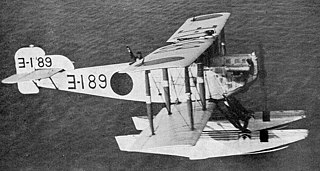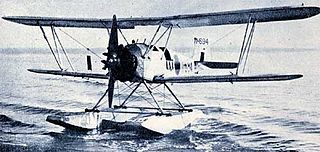Related Research Articles

The Nakajima E2N was a Japanese reconnaissance aircraft of the inter-war years. It was a single-engine, two-seat, sesquiplane seaplane with twin main floats.

The Watanabe E9W was a Japanese submarine-borne reconnaissance seaplane, the first aircraft designed by Watanabe Ironworks.

The Aichi E10A was a Japanese night reconnaissance flying boat of the 1930s. A single-engined biplane, 15 were built for the Imperial Japanese Navy as the Type 96 Night Reconnaissance Seaplane, serving from 1936 but were retired in 1941 before the Attack on Pearl Harbor.

The Yokosuka E1Y was a Japanese floatplane of the 1920s. A single-engined biplane that was designed and developed by the Yokosuka Naval Air Technical Arsenal as a reconnaissance aircraft for the Imperial Japanese Navy, 320 were built as the Type 14 Reconnaissance Seaplane, entering service in 1925 and remaining in operational service until 1932.

The Yokosuka Ro-go Ko-gata was a Japanese reconnaissance floatplane developed during the First World War by the Japanese Navy Arsenal at Yokosuka, and one of the first indigenous Japanese aircraft to enter production. There were 218 of these aircraft built for the Imperial Japanese Navy, which remained in use until 1928.

The Yokosuka K4Y was a Japanese floatplane trainer of the 1930s. A single engined two-seat biplane, 211 K4Ys were built between 1933 and 1940, serving as the Imperial Japanese Navy's basic floatplane trainer throughout the Second World War.

The Aichi AB-3 was a Japanese ship-board reconnaissance floatplane of the 1930s. The AB-3, a single-seat, single-engined biplane, was designed to equip a light cruiser Ning Hai being built in Japan for the Chinese navy, a single aircraft being accepted by the Chinese.

The Kawanishi E11K was a Japanese flying boat of the 1930s. It was designed as a night reconnaissance aircraft for the Imperial Japanese Navy (IJN) but was not accepted. The two aircraft that were built were used as transports as the Type 96 Transport Flying Boat during the Second World War.

The Yokosuka K1Y, also known as the Navy Type 13 Trainer, was a Japanese single-engined biplane trainer of the 1920s. Designed by the Japanese Navy Arsenal at Yokosuka, over 100 were built by several manufacturers and was used by the Imperial Japanese Navy well into the 1930s.
The Aichi AB-6, or Aichi Experimental 7-Shi Reconnaissance Seaplane, was a prototype Japanese reconnaissance floatplane. It was a single-engined, three-seat biplane intended for the Imperial Japanese Navy, but only one was built, the rival aircraft from Kawanishi, the E7K being preferred.
The Aichi F1A was a prototype Japanese floatplane of the 1930s. A single-engined biplane, the F1A was intended as a short-range observation aircraft suitable for operation off the Imperial Japanese navy's warships, but only two were built, the Mitsubishi F1M being selected instead.
The Yokosuka E5Y was a single-engine Japanese seaplane used for reconnaissance. The E5Y was also built by Kawanishi as the E5K

The Aichi E8A was a prototype Japanese reconnaissance floatplane of the 1930s. It was a two-seat single engined biplane built for the Imperial Japanese Navy. Only two were built.
The Kawanishi E10K, also known as Kawanishi Type T, Kawanishi Navy Type 94 Transport Seaplane and Kawanishi Navy Experimental 9-Shi Night Reconnaissance Seaplane, was a small Japanese flying boat of the 1930s. It was a single-engined biplane intended to meet a requirement for a night reconnaissance aircraft for the Imperial Japanese Navy but was not selected for production, the single prototype being converted to a transport and operated as the Navy Type 94 Transport.
The Yokosuka E6Y was a Japanese submarine-based reconnaissance seaplane developed at the Yokosuka Naval Air Technical Arsenal for the Imperial Japanese Navy during the 1920s. The prototype first flew as the Yokosho 2-Go in 1929.
The Nihon L7P was a Japanese military seaplane built during World War II in the early 1940s.
The Kawanishi E13K, company designation AM-19, was a Japanese 1930s three-seat reconnaissance floatplane.
The Watanabe K8W was a Japanese floatplane trainer designed and built by Watanabe for the Imperial Japanese Navy.

The Gasuden Jimpu or Kamikaze was a Japanese seven-cylinder air-cooled radial aircraft engine from the 1920s, 1930s and 1940s. It was the first aircraft engine produced by Tokyo Gas and Electric, often abbreviated to Gasuden, and the first production engine produced in Japan. It was produced in large numbers to power training and light aircraft before and during the Pacific War.
The Tokyo Koku Aiba-Tsubame or Tokyo Aviation Aiba-Swallow was a 1930s Japanese civil transport with seats for three passengers. It was intended to be cheap to produce so, although its fuselage was a new design, its wings and undercarriage were those of another Japanese aircraft. Two were built and flew taxi services and joyrides.
References
- ↑ Mikesh & Abe 1990, pp. 2, 286
- ↑ Mikesh & Abe 1990 , pp. 141, 240, 261
- ↑ Mikesh & Abe 1990 , pp. 260–261
- 1 2 3 4 Mikesh & Abe 1990, p. 141
- ↑ Mikesh & Abe 1990 , p. 240
- Mikesh, Robert C.; Abe, Shorzoe (1990). Japanese Aircraft 1910–1941. London: Putnam Aeronautical Books. ISBN 0-85177-840-2.